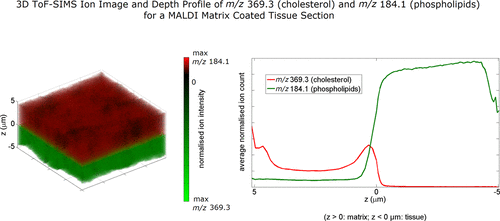当前位置:
X-MOL 学术
›
Anal. Chem.
›
论文详情
Our official English website, www.x-mol.net, welcomes your
feedback! (Note: you will need to create a separate account there.)
Insights into the MALDI Process after Matrix Deposition by Sublimation Using 3D ToF-SIMS Imaging
Analytical Chemistry ( IF 6.7 ) Pub Date : 2018-01-17 00:00:00 , DOI: 10.1021/acs.analchem.7b03993 Sebastiaan Van Nuffel 1 , Nicolas Elie 1 , Ethan Yang 2 , Julius Nouet 3 , David Touboul 1 , Pierre Chaurand 1, 2 , Alain Brunelle 1
Analytical Chemistry ( IF 6.7 ) Pub Date : 2018-01-17 00:00:00 , DOI: 10.1021/acs.analchem.7b03993 Sebastiaan Van Nuffel 1 , Nicolas Elie 1 , Ethan Yang 2 , Julius Nouet 3 , David Touboul 1 , Pierre Chaurand 1, 2 , Alain Brunelle 1
Affiliation

|
Imaging mass spectrometry (IMS) has become a powerful tool to characterize the spatial distribution of biomolecules in thin tissue sections. In the case of matrix-assisted laser desorption ionization (MALDI) IMS, homogeneous matrix deposition is critical to produce high-quality ion images, and sublimation in particular has shown to be an excellent matrix deposition method for the imaging of lipids. Matrix deposition by sublimation is, however, a completely solvent-free system, which ought to prevent the mixing of matrix and analytes thought to be necessary for successful MALDI. Using 3D time-of-flight secondary ion imaging mass spectrometry, we have studied the matrix–tissue interface in 3D with high resolution to understand the MALDI process of lipids after matrix deposition by sublimation. There is a strong indication that diffusion is the process by which lipids migrate from the tissue to the matrix layer. We show that triacylglycerols and phospholipids have a delayed migratory trend as compared to diacylglycerols and monoacylglycerols, which is dependent on time and matrix thickness. Additional experiments show that a pure lipid’s capacity to migrate into the matrix is dependent on its fluidity at room temperature. Furthermore, it is shown that cholesterol can only migrate in the presence of a (fluid) lipid and appears to fluidize lipids, which could explain its colocalization with the diacylglycerols and monoacylglycerols in the matrix.
中文翻译:

使用3D ToF-SIMS成像通过升华对基质沉积后的MALDI过程的见解
成像质谱(IMS)已成为表征薄组织切片中生物分子的空间分布的有力工具。在基质辅助激光解吸电离(MALDI)IMS的情况下,均匀的基质沉积对于产生高质量的离子图像至关重要,尤其是升华是脂类成像的出色基质沉积方法。但是,通过升华进行的基质沉积是完全无溶剂的系统,该系统应防止基质和被认为是成功MALDI所必需的分析物混合。使用3D飞行时间二次离子成像质谱仪,我们以高分辨率研究了3D的基质-组织界面,以了解通过升华基质沉积后脂质的MALDI过程。有强烈的迹象表明,扩散是脂质从组织迁移到基质层的过程。我们显示,与二酰基甘油和单酰基甘油相比,三酰基甘油和磷脂具有延迟的迁移趋势,这取决于时间和基质厚度。其他实验表明,纯脂质迁移至基质的能力取决于其在室温下的流动性。此外,已表明胆固醇只能在(流体)脂质存在下迁移并似乎使脂质流化,这可以解释其与基质中的二酰基甘油和单酰基甘油共定位。这取决于时间和基质厚度。其他实验表明,纯脂质迁移至基质的能力取决于其在室温下的流动性。此外,已表明胆固醇只能在(流体)脂质存在下迁移并似乎使脂质流化,这可以解释其与基质中的二酰基甘油和单酰基甘油共定位。这取决于时间和基质厚度。其他实验表明,纯脂质迁移至基质的能力取决于其在室温下的流动性。此外,已表明胆固醇只能在(流体)脂质存在下迁移并似乎使脂质流化,这可以解释其与基质中的二酰基甘油和单酰基甘油共定位。
更新日期:2018-01-17
中文翻译:

使用3D ToF-SIMS成像通过升华对基质沉积后的MALDI过程的见解
成像质谱(IMS)已成为表征薄组织切片中生物分子的空间分布的有力工具。在基质辅助激光解吸电离(MALDI)IMS的情况下,均匀的基质沉积对于产生高质量的离子图像至关重要,尤其是升华是脂类成像的出色基质沉积方法。但是,通过升华进行的基质沉积是完全无溶剂的系统,该系统应防止基质和被认为是成功MALDI所必需的分析物混合。使用3D飞行时间二次离子成像质谱仪,我们以高分辨率研究了3D的基质-组织界面,以了解通过升华基质沉积后脂质的MALDI过程。有强烈的迹象表明,扩散是脂质从组织迁移到基质层的过程。我们显示,与二酰基甘油和单酰基甘油相比,三酰基甘油和磷脂具有延迟的迁移趋势,这取决于时间和基质厚度。其他实验表明,纯脂质迁移至基质的能力取决于其在室温下的流动性。此外,已表明胆固醇只能在(流体)脂质存在下迁移并似乎使脂质流化,这可以解释其与基质中的二酰基甘油和单酰基甘油共定位。这取决于时间和基质厚度。其他实验表明,纯脂质迁移至基质的能力取决于其在室温下的流动性。此外,已表明胆固醇只能在(流体)脂质存在下迁移并似乎使脂质流化,这可以解释其与基质中的二酰基甘油和单酰基甘油共定位。这取决于时间和基质厚度。其他实验表明,纯脂质迁移至基质的能力取决于其在室温下的流动性。此外,已表明胆固醇只能在(流体)脂质存在下迁移并似乎使脂质流化,这可以解释其与基质中的二酰基甘油和单酰基甘油共定位。











































 京公网安备 11010802027423号
京公网安备 11010802027423号